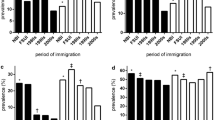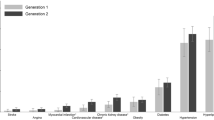Abstract
Incidence of diabetes among US foreign-born individuals is not well studied. Data were from the Multi Ethnic Study of Atherosclerosis. Cox proportional hazards regression was used to examine diabetes risk by race/ethnicity, place of birth, and duration of residence among foreign-born. Foreign-born Latinos had a higher risk of incident diabetes compared to US-born Latinos (hazard ratio (HR) 1.79 [95 % confidence interval (CI) 1.00–3.21]). Latinos born in Mexico (HR, 2.26 [95 % CI, 1.18–4.33]) had higher risk of incident diabetes compared to US-born Latinos. Foreign-born living in the US ≥20 years had a higher adjusted risk of incident diabetes compared to those in the US for <20 years (HR, 1.60 [95 % CI, 1.05–2.55]). Incident diabetes may be higher among foreign-born compared to native born; incident diabetes may also be higher among those immigrants who have lived in the US for longer periods of time. Future studies should characterize individuals by race/ethnicity and place of birth to account for differences in biology and time spent in the US.
Similar content being viewed by others
References
Centers for Disease Control and Prevention. National diabetes fact sheet: national estimates and general information on diabetes and prediabetes in the United States, 2011. Atlanta: U.S. Department of Health and Human Services, Centers for Disease Control and Prevention; 2011.
Oza-Frank R, Venkat Narayan KM. Overweight and diabetes prevalence among US immigrants. Am J Public Health. 2010;100(4):661–8.
Argeseanu Cunningham S, Ruben JD, Venkat Narayan KM. Health of foreign-born people in the United States: a review. Health Place. 2008;14:623–35.
Abraido-Lazna AF, Armbrister AN, Florez KR, Aguirre AN. Toward a theory-driven model of acculturation in public health research. Am J Public Health. 2006;96:1342–6.
Goel MS, McCarthy EP, Phillips RS, Wee CC. Obesity among US immigrant subgroups by duration of residence. JAMA. 2004;292:2860–7.
Oza-Frank R, Stephenson R, Venkat Narayan KM. Diabetes prevalence by length of residence among US immigrants. J Immigr Minor Health. 2011;13(1):1–8.
Kandula NR, Diez-Roux AV, Chan C, et al. Association of acculturation levels and prevalence of diabetes in the multi-ethnic study of atherosclerosis (MESA). Diabetes Care. 2008;31:1621–8.
The 2009 American Community Survey. Washington DC: US Census Bureau; 2010. Available at: http://www.census.gov/newsroom/releases/archives/american_community_survey_acs/cb10-cn78.html. Accessed 30 Dec 2011.
Bild DE, Bluemke DA, Burke GL, et al. The Multi-Ethnic Study of Atherosclerosis: (MESA): objectives and design. Am J Epidemiol. 2002;156:871–81.
Schmidley D. The foreign-born population in the United States: March 2002. In: US Bureau of the Census, editor. Current Population Reports. Washington: US Government Printing Office; 2003. p. 20–539.
Akresh IR. Dietary assimilation and health among Hispanic immigrants to the United States. J Health Soc Behav. 2007;48:404–17.
Report of the expert committee on the diagnosis and classification of diabetes mellitus. Diab Care 26 (suppl. 1): S5–S20, 2003.
Sanchez-Vaznaugh EV, Kawachi I, Subramanian SV, Sanchez BN, Acevedo-Garcia D. Differential effect of birthplace and length of residence on body mass index (BMI) by education, gender and race/ethnicity. Soc Sci Med. 2008;67:1300–10.
Singh G, Siahpush M. Ethnic-immigrant differentials in health behaviors, morbidity, and cause-specific mortality in the United States: an analysis of two national data bases. Hum Biol. 2002;74:83–109.
Barcenas CH, Wilkinson AV, Strom SS, Cao Y, Saunders KC, Mahabir S, et al. Birthplace, years of residence in the United States, and obesity among Mexican-American adults. Obesity. 2007;15:1043–52.
Gordon-Larsen P, Harris KM, Ward DS, Popkin BM. National Longitudinal Study of Adolescent H. Acculturation and overweight-related behaviors among Hispanic immigrants to the US: the National Longitudinal Study of Adolescent Health. Soc Sci Med. 2003;57:2023–34.
Huh J, Prause JA, Dooley CD. The impact of nativity on chronic diseases, self-rated health and comorbidity status of Asian and Hispanic immigrants. J Immigr Minor Health. 2008;10:103–18.
Park Y, Neckerman KM, Quinn J, Weiss C, Rundle A. Place of birth, duration of residence, neighborhood immigrant composition and body mass index in New York City. Int J Behav Nutr Phys Act. 2008;5:19.
Roshania R, Venkat Narayan KM, Oza-Frank R. Age at arrival and risk of obesity among US immigrants. Obesity. 2008;16(12):2669–75.
Yang EJ, Chung HK, Kim WY, Bianchi L, Song WO. Chronic diseases and dietary changes in relation to Korean Americans’ length of residence in the United States. J Am Diet Assoc. 2007;107:942–50.
Lv N, Cason KL. Dietary pattern change and acculturation of Chinese Americans in Pennsylvania. J Am Diet Assoc. 2004;104:771–8.
Raj S, Ganganna P, Bowering J. Dietary habits of Asian Indians in relation to length of residence in the United States. J Am Diet Assoc. 1999;99:1106–8.
Jasso GMD, Rosenzweig M, Smith J. Immigration, health, and New York City: early results based on the US New Immigrant Cohort of 2003. Econ Policy Rev Fed Reserv Bank NY. 2005;11(2):127.
Salant T, Lauderdale DS. Measuring culture: a critical review of acculturation and health in Asian immigrant populations. Soc Sci Med. 2003;57:71–90.
Oza-Frank R, Cunningham SA. The weight of US residence among immigrants: a systematic review. Obes Rev. 2010;11(4):271–80.
Feliciano C. Educational selectivity in U.S. immigration: how do immigrants compare to those left behind? Demography. 2005;42:131–52.
Monteiro C, Moura E, Conde W, Popkin BM. Socioeconomic status and obesity in adult populations of developing countries: a review. Bull World Health Organ. 2004;82:940–6.
Harris MI, Flegal KM, Cowie CC, et al. Prevalence of diabetes, impaired fasting glucose, and impaired glucose tolerance in U.S. adults. The Third National Health and Nutrition Examination Survey, 1988–1994. Diabetes Care. 1998;21:518–24.
Janiszewski PM, Janssen I, Ross R. Does waist circumference predict diabetes and cardiovascular disease beyond commonly evaluated cardiometabolic risk factors? Diabetes Care. 2007;30(12):3105–9.
Narayan KMV, Boyle JP, Thompson TJ, Sorensen SW, Williamson DF. Lifetime risk for diabetes mellitus in the United States. JAMA. 2003;290:1884–90.
Acknowledgments
This research was supported by contracts N01-HC-95159 through N01-HC-95169 from the National Heart, Lung, and Blood Institute (Bethesda, Maryland). The authors thank the other investigators, the staff, and the participants of the MESA study for their valuable contributions. A full list of participating MESA investigators and institutions can be found at the following Web site: http://www.mesa-nhlbi.org.
Conflict of interest
The authors have no conflicts of interest to disclose.
Author information
Authors and Affiliations
Corresponding author
Rights and permissions
About this article
Cite this article
Oza-Frank, R., Chan, C., Liu, K. et al. Incidence of Type 2 Diabetes by Place of Birth in the Multi-Ethnic Study of Atherosclerosis (MESA). J Immigrant Minority Health 15, 918–924 (2013). https://doi.org/10.1007/s10903-012-9683-6
Published:
Issue Date:
DOI: https://doi.org/10.1007/s10903-012-9683-6




